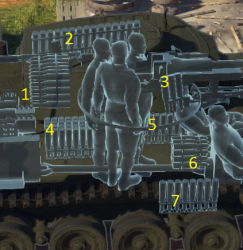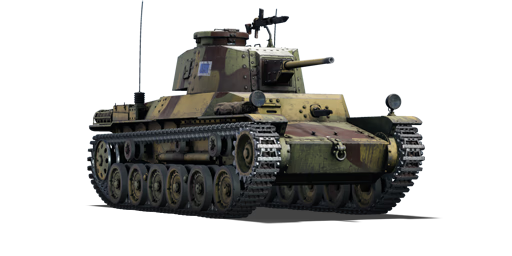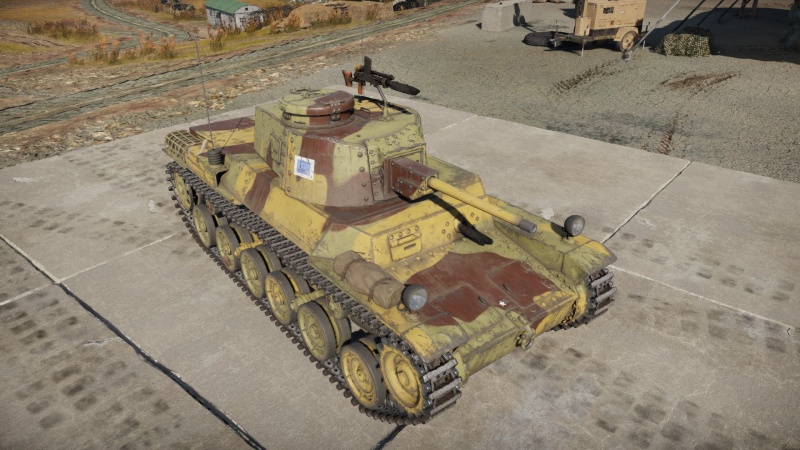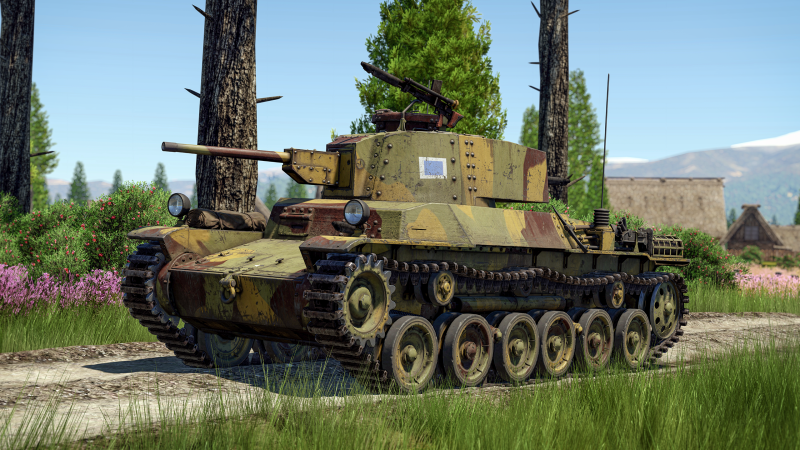Difference between revisions of "Chi-He (5th Regiment)"
(→See also) |
(→Description) |
||
| Line 14: | Line 14: | ||
The '''{{Specs|name}}''' ({{Annotation|一式中戦車(戦車第五連隊仕様)「チへ」|Ichi-Shiki Chū-Sensha (Sensha Dai Go Rentai Shiyō) [Chi-He]}}) is a regular [[Chi-He]] in service by the 1st Tank Division, 2nd Armored Brigade, 5th Armored Regiment of the Imperial Japanese Army. | The '''{{Specs|name}}''' ({{Annotation|一式中戦車(戦車第五連隊仕様)「チへ」|Ichi-Shiki Chū-Sensha (Sensha Dai Go Rentai Shiyō) [Chi-He]}}) is a regular [[Chi-He]] in service by the 1st Tank Division, 2nd Armored Brigade, 5th Armored Regiment of the Imperial Japanese Army. | ||
| − | It was introduced in [[Update "Regia Marina"]]. Being a carbon copy the [[Chi-He]], it plays exactly the same, on top of that it comes with a unique camouflage and 3 distinct decals on all available camouflages for the tank. | + | The 5th Tank Regiment was established in May 1937 in Kurume and stationed in Manchuria in 1938 as part of the Kwantung Army's 1st Tank Brigade during the Nomonhan Incident. Although better equipped than the 3rd and 4th Tank Regiments, the 5th Tank Regiment had many inexperienced soldiers, leading it to remain in reserve during the Second Nomonhan Incident and avoid combat. Afterwards, it helped establish the 10th and 11th Tank Regiments by providing personnel and equipment. During the Pacific War, the regiment continued training and security duties in Manchuria until March 1945, when it returned to Japan for homeland defence, stationed first in Tochigi and later in Saitama Prefecture. Notably, the 5th Tank Regiment never saw combat from its formation until Japan's surrender. |
| + | |||
| + | It was introduced in [[Update "Regia Marina"]]. Being a carbon copy of the [[Chi-He]], it plays exactly the same, on top of that it comes with a unique camouflage and 3 distinct decals on all available camouflages for the tank. | ||
== General info == | == General info == | ||
Latest revision as of 18:24, 25 August 2024
| This page is about the premium Japanese medium tank Chi-He (5th Regiment). For the regular version, see Chi-He. |
Contents
Description
The Type 1 Chi-He (5th Regiment) (一式中戦車(戦車第五連隊仕様)「チへ」) is a regular Chi-He in service by the 1st Tank Division, 2nd Armored Brigade, 5th Armored Regiment of the Imperial Japanese Army.
The 5th Tank Regiment was established in May 1937 in Kurume and stationed in Manchuria in 1938 as part of the Kwantung Army's 1st Tank Brigade during the Nomonhan Incident. Although better equipped than the 3rd and 4th Tank Regiments, the 5th Tank Regiment had many inexperienced soldiers, leading it to remain in reserve during the Second Nomonhan Incident and avoid combat. Afterwards, it helped establish the 10th and 11th Tank Regiments by providing personnel and equipment. During the Pacific War, the regiment continued training and security duties in Manchuria until March 1945, when it returned to Japan for homeland defence, stationed first in Tochigi and later in Saitama Prefecture. Notably, the 5th Tank Regiment never saw combat from its formation until Japan's surrender.
It was introduced in Update "Regia Marina". Being a carbon copy of the Chi-He, it plays exactly the same, on top of that it comes with a unique camouflage and 3 distinct decals on all available camouflages for the tank.
General info
Survivability and armour
There is nothing impressive here in terms of armour, the Chi-He features 50 mm, poorly angled, frontal armour. This is not the kind of plate that can take any punishment at the battle rating, as it will only bounce poorly aimed shots. The five-man crew inside makes the tank very survivable, leaving some room for mistakes. Side armour is vulnerable to heavy machine gun and autocannon fire, so beware flanking fast tanks.
Armour type:
- Rolled homogeneous armour
- Cast homogeneous armour (Gun mantlet, Machine gun ports)
| Armour | Front (Slope angle) | Sides | Rear | Roof |
|---|---|---|---|---|
| Hull | 50 mm (15°) Front plate 12 mm (76°) Front glacis 50 mm (20°) Joint plate 8.5 mm (65°) Lower glacis |
20 mm (15-30°) Top 25 mm Bottom |
20 mm (0-20°) Top 8.5 mm (63°) Bottom |
12 mm |
| Turret | 25 + 25 mm (10°) Turret front 50 mm (0-10°) Gun mantlet |
25 mm (10°) | 25 mm Turret rear 50 mm (0-57°) Machine gun port |
12 mm |
| Cupola | 50 mm | 50 mm | 50 mm | 12 mm |
Notes:
- Suspension wheels are both 15 mm thick, while tracks are 20 mm thick.
- Front of turret has bolted on 25 mm armour to total up to 50 mm thick as the rest of the front.
Mobility
| Game Mode | Max Speed (km/h) | Weight (tons) | Engine power (horsepower) | Power-to-weight ratio (hp/ton) | |||
|---|---|---|---|---|---|---|---|
| Forward | Reverse | Stock | Upgraded | Stock | Upgraded | ||
| Arcade | 49 | 10 | 17.2 | 372 | 458 | 21.63 | 26.63 |
| Realistic | 44 | 9 | 212 | 240 | 12.33 | 13.95 | |
This is one of the main features of the Chi-He, it enables it to do anything a commander want with it. Want to be first on the spot? With some skill/luck, the Chi-He can! Want to flank? follow other light tanks in the move, provide them with enhanced firepower! The enemy team is coming over? Hit the gas (in a rearward position) and fire while retreating.
Modifications and economy
Armaments
Main armament
Comparatively to other light/medium tanks at this battle rating, the 47 mm Type 1 gun is quite surprising with 77 mm of penetration at point-blank range and has a good reload speed. Plus, it fires APHE shells, which do great post-penetration damage. Comparatively, the 20-K (45 mm) gun on Soviet BR 1.0-2.7 tanks has only 62 mm of penetration in similar conditions. A top-mounted MG is really useful when dealing with unarmoured SPG and SPAA one might encounter at the BR.
One thing to keep in mind compared to Chi-Ha Kai is that it still retains the same hand-cranked turret with additional 25 mm plates to improve the frontal armour to a maximum of 50 mm. This however slows down the turret rotations speeds due the added weight.
| 47 mm Type 1 | Turret rotation speed (°/s) | Reloading rate (seconds) | |||||||||||
|---|---|---|---|---|---|---|---|---|---|---|---|---|---|
| Mode | Capacity | Vertical | Horizontal | Stabilizer | Stock | Upgraded | Full | Expert | Aced | Stock | Full | Expert | Aced |
| Arcade | 120 | -15°/+20° | ±180° | Vertical | 13.33 | 18.45 | 22.40 | 24.77 | 26.35 | 4.29 | 3.80 | 3.50 | 3.30 |
| Realistic | 8.33 | 9.80 | 11.90 | 13.16 | 14.00 | ||||||||
Ammunition
| Penetration statistics | |||||||
|---|---|---|---|---|---|---|---|
| Ammunition | Type of warhead |
Penetration @ 0° Angle of Attack (mm) | |||||
| 10 m | 100 m | 500 m | 1,000 m | 1,500 m | 2,000 m | ||
| Type 1 APHE | APHE | 77 | 75 | 67 | 58 | 50 | 44 |
| Type 1 HE | HE | 10 | 9 | 8 | 7 | 5 | 5 |
| Shell details | ||||||||||||
|---|---|---|---|---|---|---|---|---|---|---|---|---|
| Ammunition | Type of warhead |
Velocity (m/s) |
Projectile mass (kg) |
Fuse delay (m) |
Fuse sensitivity (mm) |
Explosive mass (TNT equivalent) (g) |
Ricochet | |||||
| 0% | 50% | 100% | ||||||||||
| Type 1 APHE | APHE | 808 | 1.49 | 1.2 | 9 | 22.4 | 47° | 60° | 65° | |||
| Type 1 HE | HE | 822 | 1.4 | 0.1 | 0.1 | 85.26 | 79° | 80° | 81° | |||
Ammo racks
| Full ammo |
1st rack empty |
2nd rack empty |
3rd rack empty |
4th rack empty |
5th rack empty |
6th rack empty |
7th rack empty |
8th rack empty |
9th rack empty |
10th rack empty |
11th rack empty |
Visual discrepancy |
|---|---|---|---|---|---|---|---|---|---|---|---|---|
| 120 | 91 (+29) | 76 (+44) | 73 (+47) | 62 (+58) | 51 (+69) | 40 (+80) | 29 (+91) | 21 (+99) | 15 (+105) | 9 (+111) | 1 (+119) | No |

Notes:
- Turret empty: 73 (+47) shells.
Machine guns
| 7.7 mm Type 97 | ||||
|---|---|---|---|---|
| Mount | Capacity (Belt) | Fire rate | Vertical | Horizontal |
| Hull | 3,000 (20) | 499 | -16°/+10° | ±19° |
| Pintle | 1,000 (20) | 499 | -10°/+70° | ±60° |
Usage in battles
As the successor of the Chi-Ha, the Chi-He has a redesigned hull with thicker armour, a more powerful engine and an up-armoured turret from the Chi-Ha Kai, so the front has 50 mm of effective armour overall. This will result in a very similar playstyle as the Chi-Ha Kai with the added benefits of being an upgrade.
Unlike the Type 97 Chi-Ha Kai, the Type 1 Chi-He has some more armour and a stronger engine to rely on and it is able to brawl on its own with the fast fire rate. But as previously mentioned on Main armament, the Chi-He retains the same hand-cranked turret with additional armour, slowing down the already mediocre turning time by a slight amount.
Literally on top of armour and engine upgrades, the Chi-He gets an additional pintle point anti-aircraft machine gun, even though the Type 97 7.7 mm has a low clip capacity, it can prove useful for pinning enemy units and even getting hits to down enemy planes.
The best practice for the Chi-He (and other WWII-era Japanese tanks) is to always point forward, the front armour has pre-angled sides, so angling only hurts your pre-angles and weaker side armour. It's not worth trying to get more out of the 50 mm frontal effective protection.
Enemies worth noting:
- B1 bis / ter: the B1 can easily destroy the Chi-He when using both of its guns, but when angling only the 47 mm gun is available, meaning that the Chi-He can take some hits. It is very hard to destroy the Char B1 from a distance, so get as close as possible with the ideal range being no more than 300 m. Aim at their flat hull side, turret side, hull cannon mount or the driving compartment (the near-vertical frontal armour right below the turret). Upon penetrating, the Chi-He's 47 mm APHE can knock out several crews, and your quick reload allows you to finish the rest off in time. However if the B1 has folded armour plates on their hull sides then it is a B1 ter, avoid shooting at its sides.
- M4A3 (105): This low-rank Sherman poses a huge threat to every of its opponents due to its superior armour and destructive firepower. Its armour is overall quite tough to penetrate with your small 47 mm gun, but it can be solved by careful aiming. If the M4 is within 200 m, shoot at the vertical part of its gun mantlet or its side if exposed. One penetration might not kill all the crew, however two are generally enough. If it's up close and hull down, try shooting at its gun barrel to disarm it, but one shot is not guaranteed to destroy the barrel. When the M4 is further than 400 m away, all of your shells will perform poorly at penetrating its armour, so disengage or wait until it gets closer. Remember to not get hit by it, its HEAT is able to knock the Chi-He out with ease.
Pros and cons
Pros:
- 47 mm cannon can do some decent damage
- Small profile
- Gunner supported stabilization, can take accurate shots at low speeds
- Top-mounted MG
- Fast reverse speed (2 reverse gears)
- Fast in forward motion
- Frontal transmission
- Awesome gun depression of -15°
- Fast reloading rate
Cons:
- Thin side armour means angling front armour could expose weak armour
- 47 mm is not accurate in long distance fights
- Packed 5-men crew can lead to an easy knock out if penetrated
- 50 mm front armour, poorly angled
- Big ammo racks in the turret (carry only half-ammo load)
- Long and narrow hull: hard to turn on the spot
History
Development
The Imperial Japanese Army's main tank, the Type 97 Chi-Ha, was becoming rather outdated by the turn of the decade in 1940. The 30 mm front plate armour was vulnerable to standard anti-tank weaponry and the riveted design posed a hazard to the tank crew by spalling. In 1941, work began on modernizing the design up to new industrial standards.[1]
The first step in the modernizing design was to go towards a welded design rather than riveted. The front glacis plate was also simplified into a large flat 50 mm armour plate rather than the curved one. The increased armour meant an increased weight, so the Japanese added the improved Type 100 diesel engine, capable of pumping out 240 hp to propel the tank. This new tank was accepted as the Type 1 Chi-He.[1]
During the tank's preparation for mass-production, a request by the commander of the 7th Tank Regiment calling for an improved armament on the Type 97 Chi-Ha was received by the Mitsubishi factory. With the Type 1 Chi-He still needing time to enter production levels, let alone the resources needed to manufacture completely new tanks, it was placed on hold and priority was placed on improving the Type 97. This lead to the cheaper method of adapting the Type 97 to using the Type 1 turret with the 47 mm cannon, producing the Type 97 Chi-Ha Kai. This delayed the mass-production of the Type 1 Chi-He until February 1944, resulting in only 170 tanks produced before the end of the war.[2]
Combat usage
Despite its relatively early production life over late-war Japanese tanks and its improved characteristics, the Type 1 Chi-He would see its combat life held in reserves in the Japanese home islands. They would never see use in the battlefield before Japan surrendered in August 1945.
Media
- Skins
- Videos
See also
- Related Development
- Chi-Ha (Family) - (Predecessor)
- Chi-He (Family)
- Ho-I - (Gun tank variant)
- Ka-Chi - (Inspired navy amphibious variant)
- Other vehicles of similar configuration and role
-

 Pz.38(t)
Pz.38(t) -
 Pz.III (Family) - (Early models)
Pz.III (Family) - (Early models) -
 Turan I
Turan I -
 M15/42
M15/42 -
 AMC.35 (ACG.1)
AMC.35 (ACG.1) -
 Valentine I
Valentine I -
 Lago I
Lago I
External links
References
| Mitsubishi Heavy Industries (三菱重工業株式会社) | |
|---|---|
| Light Tanks | |
| Type 95 | Ha-Go · Ha-Go Commander |
| Medium Tanks | |
| Type 89 | I-Go Ko |
| Type 97 | Chi-Ha · Chi-Ha Kai |
| Type 1 | Chi-He · Chi-He (5th Regiment) |
| Type 3 | Chi-Nu · Chi-Nu II |
| Type 4 | Chi-To · Chi-To Late |
| Type 5 | Chi-Ri II |
| SPGs | |
| Chi-Ha Derived | Ho-Ro |
| Chi-He Derived | Ho-I |
| Chi-Ri Derived | Ho-Ri Prototype · Ho-Ri Production |
| Other | Na-To · Ro-Go Exp. |
| Captured | ␗Chi-Ha · ␗Chi-Ha Kai |
| Note | Most tank designs would be contracted by the Army Technical Bureau to Mitsubishi |
| See also | Mitsubishi Heavy Industries Ltd. (Post-War) |
| Japan medium tanks | |
|---|---|
| Type 97 | Chi-Ha · Chi-Ha Kai · Chi-Ha Kai TD · Chi-Ha Short Gun |
| Type 1 | Chi-He · Chi-He (5th Regiment) · Ho-I |
| Type 3 | Chi-Nu · Chi-Nu II |
| Type 4 | Chi-To · Chi-To Late |
| Type 5 | Chi-Ri II |
| Type 61 MBT | ST-A1* · ST-A2* · ST-A3* · Type 61 |
| Type 74 MBT | ST-B2* · Type 74 (C) · Type 74 (E) · Type 74 (F) · Type 74 (G) |
| Type 90 MBT | Type 90 · Type 90 (B) · Type 90 (B) "Fuji" |
| Type 10 MBT | TKX (P)* · TKX* · Type 10 |
| Other | Ka-Chi |
| USA | ▅M4A3 (76) W · ▅M47 |
| *Prototype | |
| Japan premium ground vehicles | |
|---|---|
| Light tanks | Ha-Go Commander · Type 16 (FPS) |
| Medium tanks | Chi-Ha Short Gun · Chi-He (5th Regiment) · Ka-Chi · Chi-Nu II · Type 74 (G) · Type 90 (B) "Fuji" |
| Heavy tanks | Ro-Go · ▅Heavy Tank No.6 |
| Tank destroyers | Ho-Ri Prototype · Type 75 MLRS |






